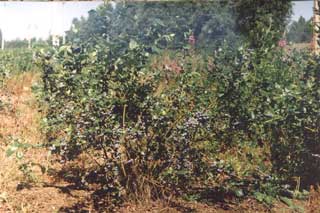In the course of our work, we encountered a number of mistakes that are regularly made by sellers of this product and, ultimately, by amateur gardeners, as a result of which the plants die. Let's dwell on them in more detail.
Firstly, all gardeners believe that it is necessary to arrange a swamp on the site, believing that in this type of blueberry grows precisely in the swamp. However, everyone saw perfectly well that it grows mainly on the outskirts of swamps or on hummocks, but never grows in a swamp. Therefore, blueberries need moderate moisture, as with most vegetable crops.
 |
Thirdly, many try to put more compost, manure and other organic fertilizers under the bush, this is also a big mistake. Blueberries practically do not need organic fertilizers. In addition, manure and compost have a neutral or slightly alkaline reaction and, therefore, shift the soil pH level to an alkaline environment, which in turn leads to chlorosis.
Fourthly, many gardeners of the Moscow region conscientiously follow the recommendations, make "wells" with acidic soil on the site, but do not take into account that there is clay soil on the site and do not lay drainage on it. During rains, water accumulates in such a "well" and does not leave it for a long time. As a result, blueberry roots are in the water for a long time, suffocate from lack of air, die off and rot, and later the whole bush also perishes.
Therefore, in order to avoid misunderstandings with the cultivation of this crop, it is better to consult a specialist. We want to give general recommendations to all gardeners who want to grow blueberries in their garden in order to avoid mistakes.
The first and most important condition for the successful cultivation of this crop is that the soil must be acidic: pH 4.0 - 5.0; but not higher than 5.5, otherwise the blueberry will develop chlorosis and it will die.
The second condition is that the soil must be well water-permeable and air-permeable (i.e. it can be sand, peat, peat-sand mixture, etc.). This is due to the fact that blueberries need not only water, but also air for breathing (the roots in the first place).
 |
The third prerequisite is that the place where the blueberry bushes are planted should be sunny (100% - I am illumination), protection from the wind is also desirable, especially from the north side.
In addition, mineral fertilizers are applied under the blueberries in the spring. For the growth of shoots, nitrogen is needed (90-100 g of ammonium sulfate per adult bush). Under the bushes, mulched with fresh sawdust, a double rate of nitrogen is introduced. Potassium is needed for root growth (40 g of potassium sulfate per 1 adult bush). To withstand stressful situations, phosphorus is needed (105-110 g of superphosphate per 1 adult bush). It is advisable to additionally add magnesium sulfate (15-20 g per 1 adult bush) and a mixture of trace elements (1-2 g per adult bush).
Moderate watering, water no more than beets, carrots, potatoes and other crops. Sawdust mulching is obligatory (it is possible once every 2-3 years). The mulch layer retains moisture in the root zone, regulates the temperature of this layer, improves the illumination of the bush, destroys weeds and prevents the development of diseases.
Of the diseases on blueberries, the following are noted:
1. stem cancer or godroniasis;
2. drying of the tops of the shoots or phomopsis;
3. gray rot.
For plant protection, fungicides are used (euparen, benomyl, rovral, topsinM, cuprozan, etc.) at a concentration of 0.2% (2 g per 1 liter of water). Spray several times in the spring before the fruit is formed and in the fall after harvest (interval 7-10 days).
In winter, adult bushes without shelter can withstand temperatures down to -25єС. At a lower temperature (-35 - -40єС), a part of the bush located above the snow level may freeze. But during the growing season, the bush is restored. To protect plants, they can be covered with spandbond (or lutrasil) or any other covering material in late October - early November.









